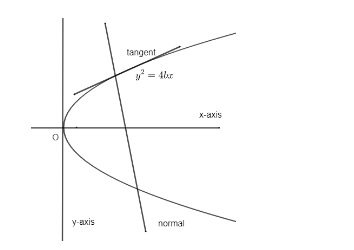Question
Question: If the normal at the point \[\left( bt_{1}^{2},2b{{t}_{1}} \right)\] on a parabola, \[{{y}^{2}}=4bx\...
If the normal at the point (bt12,2bt1) on a parabola, y2=4bx meets the curve again at point (bt22,2bt2) then,
(a) t2=t1+t12
(b) t2=−t1−t12
(c) t2=−t1+t12
(d) t2=t1−t12
Explanation
Solution
Hint : o solve this question we will first of all determine the equation of normal of given parabola. The equation of normal of parabola of type, y2=4ax ar point (x1,y1) is given by,
(y−y1)=dxdy−1(x−x1)
Complete step-by-step answer :
Given parabola is, y2=4bx this parabola and normal would be of the form.

We have equation of normal of parabola, y2=4ax is, (y−y1)=(dxdy)−1(x−x1) at point (x1,y1) - (1)
Given that equation of parabola is, y2=4bx.
Differentiating both sides with respect to x we get,
